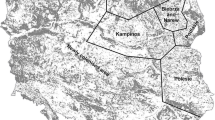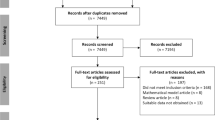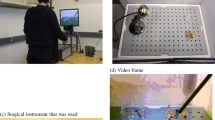Abstract
The social structure of an animal population can often influence movement and inform researchers on a species’ behavioral tendencies. Animal social networks can be studied through movement data; however, modern sources of data can have identification issues that result in multiply-labeled individuals. Since all available social movement models rely on unique labels, we extend an existing Bayesian hierarchical movement model in a way that makes use of a latent social network and accommodates multiply-labeled movement data (MLMD). We apply our model to drone-measured movement data from Risso’s dolphins (Grampus griseus) and estimate the effects of sonar exposure on the dolphins’ social structure. Our proposed framework can be applied to MLMD for various social movement applications. Supplementary materials accompanying this paper appear online.


Similar content being viewed by others
References
Blackwell PG (2003) Bayesian inference for Markov processes with diffusion and discrete components. Biometrika 90(3):613–627
Bode NW, Franks DW, Wood AJ, Piercy JJ, Croft DP, Codling EA (2012) Distinguishing social from nonsocial navigation in moving animal groups. Am Naturalist 179(5):621–632
Calabrese JM, Fleming CH, Fagan WF, Rimmler M, Kaczensky P, Bewick S, Leimgruber P, Mueller T (2018) Disentangling social interactions and environmental drivers in multi-individual wildlife tracking data. Philos Trans Royal Soc B Biol Sci 373(1746):20170007
Carretta JV, Forney KA, Oleson EM, Weller DW, Lang AR, Baker J, Muto MM, Hanson B, Orr AJ, Huber H, Lowry MS, Barlow J, Moor JE, Lynch D, Carswell L, Jr, R. LB (2019). U.S. Pacific Marine Mammal Stock Assessments: 2018. Technical report, Southwest Fisheries Science Center (U.S.)
Couzin ID, Krause J, Franks NR, Levin SA (2005) Effective leadership and decision-making in animal groups on the move. Nature 433(7025):513–516
Dawson S, Bowman M, Leunissen E, Sirguey P (2017) Inexpensive aerial photogrammetry for studies of whales and large marine animals. Front Marine Sci 4:366
de Valpine P, Paciorek C, Turek D, Michaud N, Anderson-Bergman C, Obermeyer F, Wehrhahn Cortes C, Rodrìguez A, Temple Lang D, Paganin S (2022) NIMBLE: MCMC, Particle filtering, and programmable hierarchical modeling. R package version 0.12.2
de Valpine P, Turek D, Paciorek C, Anderson-Bergman C, Temple Lang D, Bodik R (2017) Programming with models: writing statistical algorithms for general model structures with NIMBLE. J Comput Graph Stat 26:403–413
Delgado MD, Penteriani V, Morales JM, Gurarie E, Ovaskainen O (2014) A statistical framework for inferring the influence of conspecifics on movement behaviour. Methods Ecol Evol 5(2):183–189
Durban J, Fearnbach H, Barrett-Lennard L, Perryman W, Leroi D (2015) Photogrammetry of killer whales using a small hexacopter launched at sea. J Unmanned Vehicle Syst, 3(3):131–135
Durban JW, Southall B, Calambokidis J, Casey C, Fearnbach H, Joyce TW, Fahlbusch J, Oudejans MG, Fregosi S, Friedlaender AS, Kellar NM, Visser F (2022) Integrating remote sensing methods during controlled exposure experiments to quantify group responses of dolphins to navy sonar. Marine Pollution Bull, 174:113194
Hartman KL, Visser F, Hendriks AJ (2008) Social structure of Risso’s dolphins (Grampus griseus) at the Azores: a stratified community based on highly associated social units. Can J Zool 86(4):294–306
Haydon DT, Morales JM, Yott A, Jenkins DA, Rosatte R, Fryxell JM (2008) Socially informed random walks: incorporating group dynamics into models of population spread and growth. Proc Royal Soc B Biol Sci 275(1638):1101–1109
Hooten MB, Johnson DS, McClintock BT, Morales JM (2017a) Continuous-time models. In: Animal movement: statistical models for telemetry data. CRC Press
Hooten MB, Johnson DS, McClintock BT, Morales JM (2017b) Discrete-time models. In: Animal movement: statistical models for telemetry data. CRC Press
Johnson DS, London JM, Lea M-A, Durban JW (2008) Continuous-time correlated random walk model for animal telemetry data. Ecology 89(5):1208–1215
Kossinets G (2006) Effects of missing data in social networks. Social Netw 28(3):247–268
Langrock R, Hopcraft JGC, Blackwell PG, Goodall V, King R, Niu M, Patterson TA, Pedersen MW, Skarin A, Schick RS (2014) Modelling group dynamic animal movement. Methods Ecol Evol 5(2):190–199
Lusseau David NME (2004) Identifying the role that animals play in their social networks. Proc R Soc Lond B 271:477–481
Milner JE, Blackwell PG, Niu M (2021) Modelling and inference for the movement of interacting animals. Methods Ecol Evol 12(1):54–69
Niu M, Blackwell PG, Skarin A (2016) Modeling interdependent animal movement in continuous time. Biometrics 72(2):315–324
Niu M, Frost F, Milner JE, Skarin A, Blackwell PG (2020) Modelling group movement with behaviour switching in continuous time. Biometrics 78(1):286–299
Rice AC, Rafter M, Trickey JS, Wiggins SM, Baumann-Pickering S, Hildebrand JA (2020) Passive acoustic monitoring for marine mammals in the SOCAL range complex July 2018-May 2019. Technical report, Scripps Institution of Oceanography
Rue H, Held L (2005) Gaussian markov random fields: theory and applications. CRC Press, Boca Raton
Scharf HR, Buderman FE (2020) Animal movement models for multiple individuals. Wiley Interdiscip Rev Comput Stat 12(6):e1506
Scharf HR, Hooten MB, Fosdick BK, Johnson DS, London JM, Durban JW (2016) Dynamic social networks based on movement. Ann Appl Stat 10(4):2182–2202
Scharf HR, Hooten MB, Johnson DS, Durban JW (2018) Process convolution approaches for modeling interacting trajectories. Environmetrics, 29(3):e2487
Torney CJ, Lamont M, Debell L, Angohiatok RJ, Leclerc L-M, Berdahl AM (2018) Inferring the rules of social interaction in migrating caribou. Philos Trans Royal Soc B Biol Sci 373(1746):20170385
Weiss MN, Ellis S, Croft DP (2021) Diversity and consequences of social network structure in toothed whales. Canadian J Zool, 921. https://doi.org/10.3389/fmars.2021.688842
Whitehead H, Rendell L (2021) The cultural lives of whales and dolphins. University of Chicago Press
Acknowledgements
Funding for the collection of the dolphin data was provided by the U.S. Navy’s Office of Naval Research (Awards N000141713132, N0001418IP-00021, N000141712887, N000141912572). Drone flights over dolphins were authorized by research permit 19091 from the National Marine Fisheries Service (NMFS), and the controlled sonar exposure experiment was conducted under NMFS permit 19116.
Author information
Authors and Affiliations
Corresponding author
Ethics declarations
Data availability
The authors declare that the data supporting the findings of this study are available within the article’s supplementary information files. Supplementary files containing all data and code needed to reproduce the figures and results in this manuscript will be provided upon acceptance for publication.
Additional information
Publisher's Note
Springer Nature remains neutral with regard to jurisdictional claims in published maps and institutional affiliations.
Supplementary Information
Below is the link to the electronic supplementary material.
Supplementary file 3 (mp4 7653 KB)
Rights and permissions
Springer Nature or its licensor (e.g. a society or other partner) holds exclusive rights to this article under a publishing agreement with the author(s) or other rightsholder(s); author self-archiving of the accepted manuscript version of this article is solely governed by the terms of such publishing agreement and applicable law.
About this article
Cite this article
Boulil, Z.L., Durban, J.W., Fearnbach, H. et al. Detecting Changes in Dynamic Social Networks Using Multiply-Labeled Movement Data. JABES 28, 243–259 (2023). https://doi.org/10.1007/s13253-022-00522-1
Received:
Revised:
Accepted:
Published:
Issue Date:
DOI: https://doi.org/10.1007/s13253-022-00522-1




